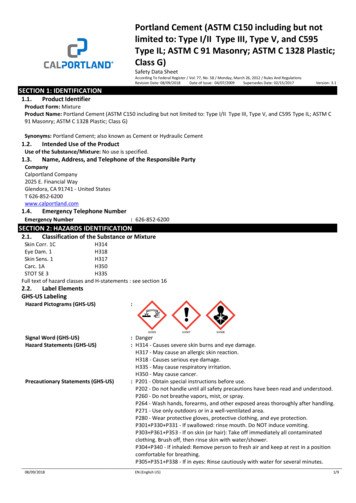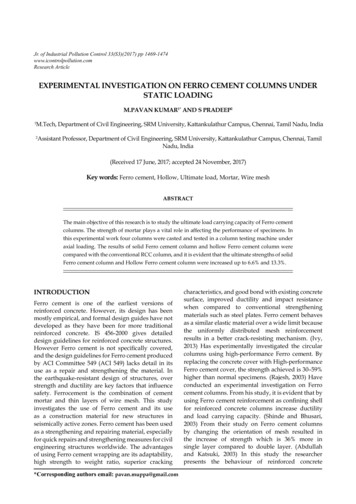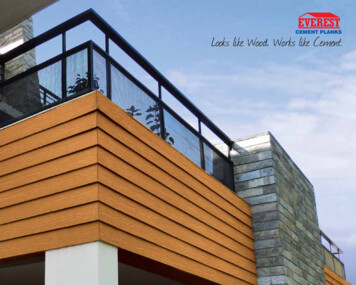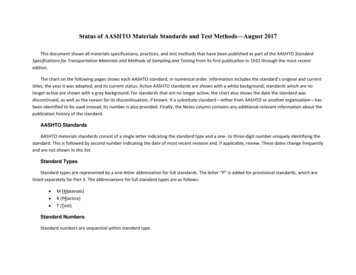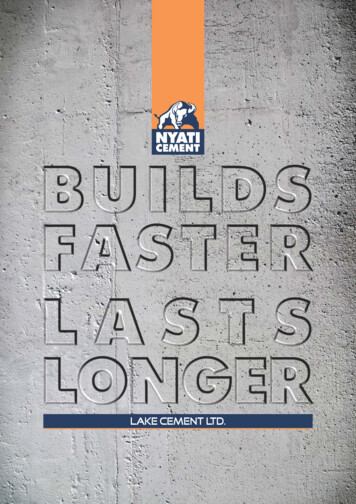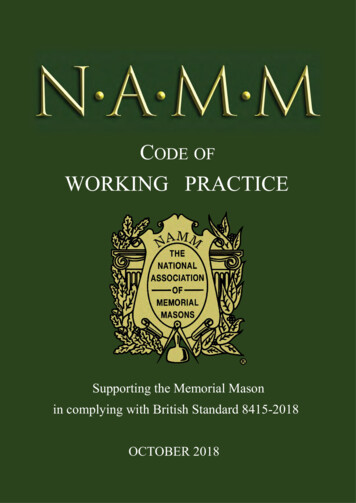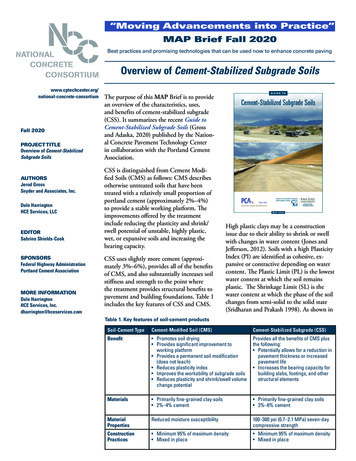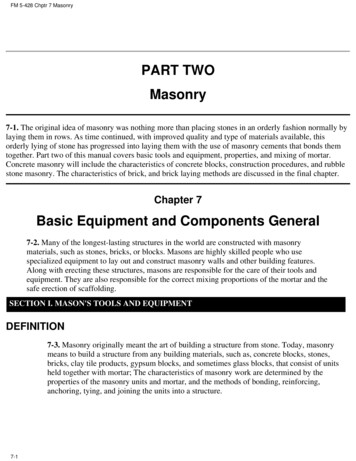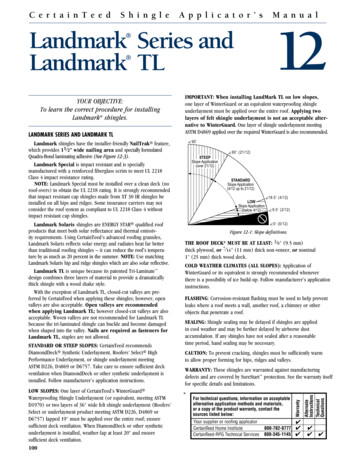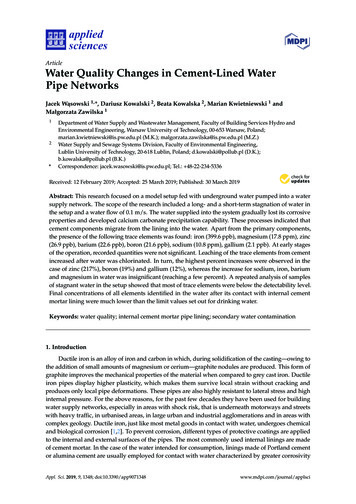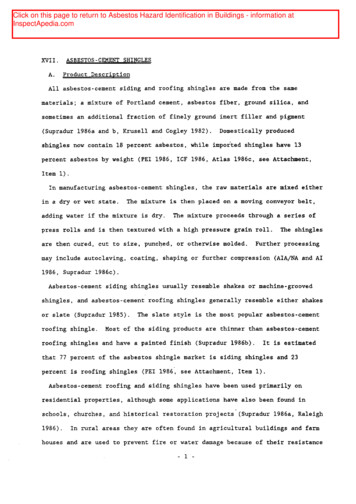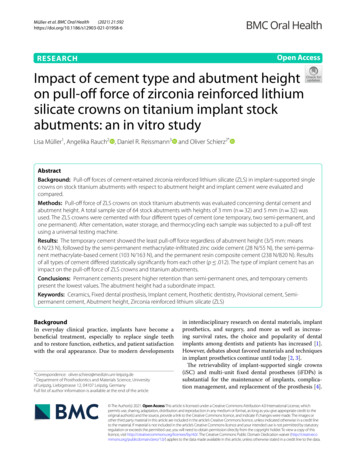
Transcription
(2021) 21:592Müller et al. BMC Oral en AccessRESEARCHImpact of cement type and abutment heighton pull‑off force of zirconia reinforced lithiumsilicate crowns on titanium implant stockabutments: an in vitro studyLisa Müller1, Angelika Rauch2 , Daniel R. Reissmann3and Oliver Schierz2*AbstractBackground: Pull-off forces of cement-retained zirconia reinforced lithium silicate (ZLS) in implant-supported singlecrowns on stock titanium abutments with respect to abutment height and implant cement were evaluated andcompared.Methods: Pull-off force of ZLS crowns on stock titanium abutments was evaluated concerning dental cement andabutment height. A total sample size of 64 stock abutments with heights of 3 mm (n 32) and 5 mm (n 32) wasused. The ZLS crowns were cemented with four different types of cement (one temporary, two semi-permanent, andone permanent). After cementation, water storage, and thermocycling each sample was subjected to a pull-off testusing a universal testing machine.Results: The temporary cement showed the least pull-off force regardless of abutment height (3/5 mm: means6 N/23 N), followed by the semi-permanent methacrylate-infiltrated zinc oxide cement (28 N/55 N), the semi-permanent methacrylate-based cement (103 N/163 N), and the permanent resin composite cement (238 N/820 N). Resultsof all types of cement differed statistically significantly from each other (p .012). The type of implant cement has animpact on the pull-off force of ZLS crowns and titanium abutments.Conclusions: Permanent cements present higher retention than semi-permanent ones, and temporary cementspresent the lowest values. The abutment height had a subordinate impact.Keywords: Ceramics, Fixed dental prosthesis, Implant cement, Prosthetic dentistry, Provisional cement, Semipermanent cement, Abutment height, Zirconia reinforced lithium silicate (ZLS)BackgroundIn everyday clinical practice, implants have become abeneficial treatment, especially to replace single teethand to restore function, esthetics, and patient satisfactionwith the oral appearance. Due to modern developments*Correspondence: oliver.schierz@medizin.uni-leipzig.de2Department of Prosthodontics and Materials Science, Universityof Leipzig, Liebigstrasse 12, 04107 Leipzig, GermanyFull list of author information is available at the end of the articlein interdisciplinary research on dental materials, implantprosthetics, and surgery, and more as well as increasing survival rates, the choice and popularity of dentalimplants among dentists and patients has increased [1].However, debates about favored materials and techniquesin implant prosthetics continue until today [2, 3].The retrievability of implant-supported single crowns(iSC) and multi-unit fixed dental prostheses (iFDPs) issubstantial for the maintenance of implants, complication management, and replacement of the prosthesis [4]. The Author(s) 2021. Open Access This article is licensed under a Creative Commons Attribution 4.0 International License, whichpermits use, sharing, adaptation, distribution and reproduction in any medium or format, as long as you give appropriate credit to theoriginal author(s) and the source, provide a link to the Creative Commons licence, and indicate if changes were made. The images orother third party material in this article are included in the article’s Creative Commons licence, unless indicated otherwise in a credit lineto the material. If material is not included in the article’s Creative Commons licence and your intended use is not permitted by statutoryregulation or exceeds the permitted use, you will need to obtain permission directly from the copyright holder. To view a copy of thislicence, visit http:// creat iveco mmons. org/ licen ses/ by/4. 0/. The Creative Commons Public Domain Dedication waiver (http:// creat iveco mmons. org/ publi cdoma in/ zero/1. 0/) applies to the data made available in this article, unless otherwise stated in a credit line to the data.
Müller et al. BMC Oral Health(2021) 21:592In general, restorations can be screw-retained, cementretained, or fixed with a combination of both [5]. Regarding the survival of the implant, no clinically relevantdifferences were described between the rates of cementor screw-retained iSCs during the first five years. Thus,both fixation methods can be recommended for implantsupported restorations [3]. In the presence of limitedinterocclusal space of 4 mm, screw-retained structuresare preferred [6]. Advantages of cement-retained iSCs arethe provision of a more passive fit of the crown, as well asbetter esthetical and occlusal features [7]. Due to reducedcosts and the simplicity of the procedure, 60% of Germanclinical practitioners prefer cementation on implant abutments [5, 8]. In comparison to screw-retained crownsconventional cementation can avoid common technical complications such as screw loosening or mechanical damage of the implant components. Furthermore, nospecial devices are needed for the conventional approachand the procedures follow the same routine as for naturalabutment teeth [7].However, for the long-term success of dental prosthesis implant-related biological complications are important too. Biological complications refer to soft andhard tissue diseases. One of the main disadvantages ofcemented crowns is the risk of undetected cement residue that could lead to inflammatory reactions and periimplant complications, like peri-implantitis, peri-implantmucositis, soft tissue hypertrophy, or recession up tobone loss and necessary deplantation [9]. Studies prove,that biological challenges are higher with cement-retention than screw-retained implant-supported fixed dentures [10, 11].Dental cements can be classified as temporary, semipermanent, and permanent. Temporary cements havebeen developed for short-term fixation and intendeddebonding. Therefore, they are inherently weak and soluble in the oral environment [12]. For the cementationof iSCs and iFDPs, a class of semi-permanent cementshas been developed that accomplishes a chemical bondbetween the abutment and the restoration [13, 14]. Thesecements should be characterized by sufficient strength,which avoids unintentional decementation and providesreliable intended decementation when needed. Thataspect showed to be tremendous progress in the development of dental cements [15–17]. Many authors and clinicians recommend temporary cementation to facilitateretrievability of iSCs and iFDPs without damage [18, 19].Factors affecting cemented iSCs and iFDPs are similarto those on natural teeth and are characterized by type ofluting agent, film thickness, the roughness of the bondingsurface, taper, width, and height of the abutments [13, 15,20]. In situations of limited interocclusal space, shorterabutments are mandatory, even if the small height mayPage 2 of 8become a limiting factor for clinical success. Therefore,an investigation on pull-off forces regarding differentabutment heights and different types of implant cementscan provide valuable information for clinicians.The purpose of this study was to evaluate and compare pull-off force of cement-retained zirconia reinforced lithium silicate iSCs on stock titanium abutmentswith respect to abutment height and implant cement.Regarding the pull-off force, the null-hypothesis statesthat there is no significant difference in iSCs made fromZLS bonded with four different dental implant cementsto stock titanium abutments. The secondary hypothesisstates that there is no difference in pull-off force regarding the abutment height.MethodsFor sample size calculation, data from preliminary pulloff tests were used. A pull-off force difference of 50 Nbetween both heights was assumed as clinically relevant.Estimating a standard deviation of 30 N and a power of0.9, calculations revealed a sample size of 8 per group (intotal 64 samples when using four different cements andtwo different abutment heights) using a two-sample test(STATA 15.1 College Station, TX: StataCorp LLC).A number of 24 stock titanium abutments (CAMLOGiSy Esthomic abutments, CAMLOG Vertriebs GmbH,Germany) were physically available for the testing process. The abutments were delivered with a pronouncedchamfer and tapering of 7.5 degrees. Half of the abutments were customized manually to a height of 3 mmand the other was customized to a height of 5 mm byusing a Red Milling Cutter (A. M. Edelingh M W Dental, Germany). A mold was designed and fabricated, withthe help of which the implant analogs were embeddedin polymer blocks (Paladur , Kulzer GmbH, Germany).Each stock abutment was screw-retained to the implantanalog with 20 Ncm torque with a manufacturer-supplied manual torque controller (CAMLOG Biotechnologies AG, Germany). After cleaning with isopropanol,screw access openings were filled with a temporaryresin composite material (Telio CS, Ivoclar VivadentAG, Liechtenstein). A gingival mask was handmade withaddition-curing vulcanizing silicone (GumQuick, DreveDentamid GmbH, Germany) for digitization of the stockabutments (Omnicam, CEREC Premium SW 4.5, Dentsply Sirona Deutschland GmbH, Germany).All shorted stock abutments were scanned and an associated individual iSC was designed as upper left secondpremolars using a form template (inLab SW 4.6.1, Dentsply Sirona Deutschland GmbH, Germany). A spacer of120 μm was set [21]. A number of 24 monolithic ceramiccrowns made of zirconia reinforced lithium silicate(VITA SUPRINITY , VITA Zahnfabrik H. Rauter GmbH
Müller et al. BMC Oral Health(2021) 21:592Page 3 of 8Fig. 1 Exemplary sample; implants analogue embedded in polymerblocks and milled and crystalized monolithic crown& Co. KG, Germany) were milled (inLab MCXL, Dentsply Sirona Deutschland GmbH, Germany) from ZLSblocks of 12 14 18 mm.The milled crowns were separated from the block andthe lug was removed with a diamond-coated millinginstrument. The iSCs were manually cleaned, air-dried,and crystallized according to the manufactures’ instructions (Programat EP5000; Ivoclar Vivadent AG, USA). Allcrowns were polished, as recommended by the manufacturer. To reassociate the iSC to its abutment, eachsample was numbered (Fig. 1). The bonding surfaces ofthe finished crowns were airborne abraded with 50 μm Al2O3-particles at a pressure of one bar, duration of 10 s,and a distance of 10 mm [22]. All restorations and abutments were purged with isopropanol (70%) and air-driedimmediately before cementation.The cements (Table 1) were applied into the innerlumen of the restoration up to the cervical third of thecrown and carefully placed on the corresponding stockabutment. Before the cementation with permanent resincomposite cement, the inner surface of the crown wasconditioned for 60 s (Monobond Plus, Ivoclar VivadentGmbH, Germany) and the surplus removed by air current. Subsequently, all restorations were placed on thestock abutment and kept in place for 10 s. Thereafter, allsamples were axially loaded with 50 N for about 10 minunder room conditions (21 C and 50% humidity).After 24 h water storage at 37 C, all samples wereloaded with 37,500 thermal cycles (Thermocycler HaakeDC 10, W 15, Thermo Haake GmbH, Germany), corresponding to a lifetime of approximately 4 years in vivo[23], making the study comparable to clinical short-termstudies [5]. For thermocycling, two water baths werefilled with 5 C and 55 C tempered, distilled water witha dwell time of 30 s and a transition time of 10 s. Bothtemperature data correspond to the median value of themeasured maximum and minimum temperatures in theoral cavity [23].Afterwards, each sample was clamped into a custommade device setting (Fig. 2) (Zwick Roell Z010, Test Xpert II V2.2, ZwickRoell GmbH & Co. KG, Germany).The crowns were axially removed with a crossheadspeed of 2 mm/min and a preload of 4 N. The AdhesiveRemnant Index [24] was registered according to Table 2immediately after the crown removal, to record the quantitative affinity of the cements for abutment and crownsurfaces.The available 24 stock abutments and belonging crownsof both heights were refurbished up to two times, so atotal amount of 64 tests in both abutment heights couldbe performed. The intactness and complete purificationof the inner and outer surface of crown and abutmentwere visually inspected with magnifying glasses (magnification 2.5). Every luting agent was tested eight times withTable 1 Classification and main components of the used luting agentsTrading name(abbreviation)TempBond NE (TBNE)Harvard Implant (HI)TypeManufacturerClassificationMain componentsZinc oxide cement(chemical curing)KerrHawe SA, SwizerlandTemporary [17]Zinc oxide, zinc acetate dihydrateMethylacrylate-infiltratedzinc oxide cement(dual curing)Havard Dental Intl GmbH,GermanySemi-permanentZinc oxide, multifunctionalmethacrylatesComposite cement(self-adhesive, dual curing)Ivoclar Vivadent GmbH,GermanyPremier Implant Cement Methacrylate-based cement(PI)(chemical curing)SpeedCEM Plus(SCP)Premier Dental Products Com- Semi-permanent [17] Triethylenglycoldi-methacrylate,pany, Pennsylvania USAfumed silica, 2-hydroxy-ethylmethacrylate, benzoyl late,polyethylenglycoldi-methacrylate, ytterbium sphat
Müller et al. BMC Oral Health(2021) 21:592Page 4 of 8Fig. 3 Flowchart; TBNE TempBond NE a temporary zincoxide-based cement, HI Harvard Implant a semi-permanentmethacrylate-infiltrated zinc oxide cement, PI Premier ImplantCement a semi-permanent methacrylate-based cement,SCP SpeedCEM Plus a permanent composite cement,AH abutment heightFig. 2 Custom-made device setting in the universal testing machine,for measurement of the pull-off forceTable 2 Codes for visual, quantitative classification of thecement remnants on the abutments and in the crowns(modified Adhesive Remnant Index [24])CodesInterpretation1Cement adheres completely to the abutment2More than 50% of the cement adheres to the abutment3More than 50% of the cement adheres in the crown4Cement adheres completely in the crowneach abutment height. All 64 samples (Fig. 3) were processed in randomized order according to the flowchart.Data were statistically analyzed with SPSS (V27.0.0.0,IBM Deutschland GmbH, Germany) applying one-wayANOVA to test whether there was a difference concerning the applied type of cement, and t-test to figureout differences regarding abutment height and the comparison between the 4 cements. To estimate the effectsize, Cohen’s d was calculated and interpreted afterSawilowsky [25]. The results of the Adhesive RemnantIndex were statistically evaluated by using the Kruskal–Wallis-Test, and Mann–Whitney-U-Test was used to figure out differences regarding the different cements.ResultsThe temporary zinc oxide-based cement (TBNE) showedthe least mean pull-off force regardless of the abutmentheight (3 mm/5 mm: means 6 N/23 N), followed by thesemi-permanent methacrylate-infiltrated zinc oxidecement (HI) (28 N/55 N), the semi-permanent methacrylate-based cement (PI) (103 N/163 N) and the permanent composite cement (SCP) (238 N/820 N). In thetemporary cement group, more than half of the crownsdebonded spontaneously. Samples bonded with the twostrongest implant cements (PI and SCP) showed damagesof the crowns while removal in both abutment heights(PI: 12.5%; SCP: 25.0%).The statistical analysis revealed a significant differenceand a huge effect size (d 2.0) for abutment height whenusing SCP and HI. There were no statistically significantdifferences between the pull-off forces regarding theabutment height in the groups of PI and TBNE (Table 3).Moreover, statistically significant differences in pull-offforces between all cements and an abutment height of3 mm and 5 mm were detected, as well as very large tohuge effect sizes (Tables 4, 5). Solely the pairing of TBNEand HI on 5 mm abutment height presented no statistically significant differences in pull-off force (Table 5) andsmall effect size (d 0.2).Table 6 depicts the residues of the remnant cementon an abutment and/or crown. The temporary cementleft most of the residue on the titanium surface of the
Müller et al. BMC Oral Health(2021) 21:592Page 5 of 8Table 3 Pull-off force with respect to cement and abutment heightCement3 mm abutment heightMean (SD) in N5 mm abutment heightRange in NMean (SD) in NStatisticalsignificanceRange in NEffect sizeTBNE6 (12)60–2723 (21)30–54HI28 (6)22–3755 (39)8–102p 0.001*0.97PI103 (40)#149–180163 (96)#171–310820 (180)#2550–1170p 0.1320.8366–525SCP238 (131)#2p 0.0740.99p 0.001*3.70(a) Asterisks (*) mark statistically significant differences(b) X#n marks the count of crown fractures(c) Xn marks the count of premature debondingTable 4 Probability of statistically significant differences andeffect size of cement pairings 3 mm abutment heightTable 7 Probability of statisticallyregarding observed cement remnantsTBNEHI2.4p 0.001*PIp 0.001*SCPp 0.002*p 0.001*2.5TBNE2.3HIp 0.001*PIp 0.001*SCPp 0.001*1.4p 0.003*TBNE3.32.6p 0.023*HIPISCP(a) Asterisk (*) marks statistically significant differencesTable 5 Probability of statistically significant differences andeffect size of cement pairings 5 mm abutment heightTBNEPISCP0.3p 0.068p 0.004*p 0.002*2.06.21.55.94.6p 0.001*p 0.001*p 0.001*TBNEHIPISCP(a) Asterisk (*) marks statistically significant differences(b) Interpretation effect size: 0.2 small; 0.5 medium; 0.8 large; 1.2 verylarge; 2.0 hugeTable 6 Observed cement remnants; for codes refer to Table 2CementCode (modified adhesive remnant index)Code 1 (%)Code 2 (%)Code 3 (%)Code 4 SCP0068.7531.25p 0.834p 0.023*HIp 0.015*PIdifferencesSCPAsterisk (*) marks statistically significant differences(b) Interpretation effect size: 0.2 small; 0.5 medium; 0.8 large; 1.2 verylarge; 2.0 hugeHITBNEsignificantabutment. The semi-permanent and permanentcements quantitatively rather remained on the insideof the crown after removal from the abutment. TheKruskal–Wallis-Test shows statistically significant differences between all cements regarding their cement residues (p 0.001).Solely, no statistically significant difference was foundbetween PI and HI (Table 7).DiscussionBoth null hypotheses stating that there is no difference inpull-off force between the chosen types of cement as wellas that there is no difference in pull-off force between theabutment heights has to be rejected. Permanent implantcements presented a higher pull-off force than semi-permanent ones. However, the latter have a higher pull-offforce than temporary cements. The unintended retention loss of 56.0% of the temporary cemented (TBNE)crowns was disproportionally high. With the semi-permanent methacrylate-based cement (PI), the secondhighest results of pull-off forces could be achieved butcrown fractures were present. The pull-off force observedin semi-permanent methacrylate-infiltrated zinc oxidecement (HI) was high enough to avoid unintentionallosses and low enough to avoid crown fractures duringthe removal.This study confirmed that permanent cements (SCP)show higher pull-off forces than semi-permanent ones(like PI and HI), which in return show higher pull-offforces than temporary cements (TBNE) [14]. As shown inprevious studies, temporary cements presented increasedunintentional decementations [5]. Glutekin et al. [17]
Müller et al. BMC Oral Health(2021) 21:592compared seven implant-cements and observed a significant difference between semi-permanent methacrylatebased cement (PI) and TBNE, which is consistent withthe results of this study. Lopez et al. [19] demonstratedthat resin-based cements such as PI and HI have statistically significantly higher pull-off force compared to thetemporary cement group and regardless of the crownmaterial. Silva et al. [26] observed similar results by testing zirconia crowns on titanium abutments. Due to itslow solubility and high mechanical and sealing properties, resin-based semi-permanent cements are mosteffective in preventing microleakages [27]. This mightexplain the comparable but not equal results of PI and HIwhose pull-off forces were less than those of the permanent cement but higher than for the provisional cement.According to the observed cement remnants, allcements differ statistically significant from each other,except the two semi-permanent cements. Semi-permanent and permanent cement groups showed a higheraffinity for the ZLS surface of the crowns than for thetitanium surface of the abutments. The high adhesionof the cement residues to the crown surface of the permanent cement may be due to the previous silanization[28, 29]. The highest pull-off forces were achieved by thepermanent composite cement, and therefore the risk ofdamaging the restoration is increased, which is corroborated by the fractured crowns during the removal trial.The null hypothesis that the abutment height has norelevant impact on the pull-off force has to be partiallyrejected. Except for the use of SCP and HI the abutmentheight showed no statistically significant impact on thepull-off force. Other studies showed an increasing pulloff force by increasing abutment height (from 4 to 6 mm)in permanent cements, which corroborates the result ofthis investigation [30]. Pull-off forces of temporary andsemi-permanent cements luting ZLS crowns to titaniumabutments were not relevantly affected by different abutment heights in other studies [26]. Sarfaraz et al. [15]used PI and TBNE and presented comparable resultsexamining height differences of 1.5 mm. The abutmentheight has tremendous importance in everyday clinicalpractice and is supported by the large effect sizes in ourstudy. Customized abutments are an existing alternative that shows a lower risk of crown loosening in comparison to stock abutments [31]. In cases of limited spacecustomized abutments should be considered to improveretention. The combination of different surface treatmentcombinations of sandblasting and primer applicationcould improve retrievability when using stock abutments[32]. Other studies observed significant differences inpull-off forces affected by abutment height when usingtitanium abutments and zirconia crowns or titaniumabutments and cobalt-chromium crowns [33, 34].Page 6 of 8In this study, high standard deviations were found.This phenomenon may be partially attributed to thereuse of the crowns and stock titanium abutments,which were reset manually by sandblasting and cleansing. Potentially repeated refurbishing of the stock abutment and crown surface may cause alteration in surfaceroughness of the titanium and ZLS surface [35, 36]. Forthis reason we limited the reuse of the crowns to twotimes. Naumova et al. [37] proved that a combinationof sandblasting and repeated cementation of implantsupported cobalt-chromium crowns leads to reducedretention force independent of the luting agent. Additionally, the adjustment of the abutment heights andthe closing of the screw access hole were carried outmanually. In summary, it could be considered that thesurfaces of each stock titanium abutment were slightlydifferent in each test. Nonetheless, the procedurereflects a standard situation in daily dental practice.ConclusionsFor clinical purposes, it seems impossible to define the“best” cement for all implant situations. Instead, a ranking of types of cement should be sought and dependence of the abutment height should be kept in mind[21]. Due to the high number of spontaneous decementations and low pull-off forces, the use of a temporarycement for luting cannot be recommended. In cases ofretention loss, clinicians can choose alternative lutingagents in ascending order [13, 16]. Based on the resultsmade in the present investigation a ranking of implantcements can be made as follows: TBNE HI PI SCP.However, semi-permanent cementation, here with PIand HI, seems to be the most suitable in the case ofluting ZLS crowns to stock titanium abutments, as thepull-off forces were high enough to ensure a low risk ofunintended debonding and low enough for a predictable successful attempt of intended debonding. For further investigations, it would be a necessity to define theseparation between temporary, semi-permanent, andpermanent types of cement. Within our investigationand the limitations of this in-vitro study, the semi-permanent methacrylate-infiltrated zinc oxide cement (HI)presented as favorable for semi-permanent cementation of ZLS crowns on titanium abutments.AbbreviationsZLS: Zirconia reinforced lithium silicate; iSC: Implant-supported single crowns;iFDPs: Multi-unit fixed dental prostheses; TBNE: TempBond NE ; HI: HarvardImplant ; PI: Premier Implant Cement ; SCP: SpeedCEM Plus.AcknowledgementsNot applicable.
Müller et al. BMC Oral Health(2021) 21:592Authors’ contributionsLM and acquired and analyzed all data included in the present article andperformed the preparation of the manuscript under the supervision of OS. ARand DR revised the work and approved the submitted version. All authors readand approved the final manuscript.FundingOpen Access funding enabled and organized by Projekt DEAL. The work wassupported by the Oral Reconstruction Foundation. We highly appreciate thework by Mrs. Francoise Peters for the logistic assistance and the substantialfinancial support of this project (ORF 217).Availability of data and materialsThe datasets analyzed during the current study are available from the corresponding author on reasonable request.DeclarationsEthics approval and consent to participateNot applicable.Consent for publicationNot applicable.Competing interestsThe authors declare that they have no competing interests.Author details1Nossen, Germany. 2 Department of Prosthodontics and Materials Science,University of Leipzig, Liebigstrasse 12, 04107 Leipzig, Germany. 3 Departmentof Prosthetic Dentistry, University Medical Center Hamburg-Eppendorf, Martinistrasse 52, 20246 Hamburg, Germany.Received: 24 July 2021 Accepted: 5 November 2021References1. Bains SK, Bhatia A. Assessment of outcome of dental implant therapy indifferent age groups—a clinico-radiographic study. Int J Res Health AlliedSci. 2019;5:1.2. Wittneben JG, Joda T, Weber HP, Brägger U. Screw retained vs. cementretained implant-supported fixed dental prosthesis. Periodontol 2000.2017;73:1.3. Sailer I, Mühlemann S, Zwahlen M, Hämmerle CH, Schneider D.Cemented and screw-retained implant reconstructions: a systematicreview of the survival and complication rates. Clin Oral Implants Res.2012;23:163–201.4. Priest G. Virtual-designed and computer-milled implant abutments. J OralMaxillofac Surg. 2005;63:22–32.5. Chaar MS, Att W, Strub JR. Prosthetic outcome of cement-retainedimplant-supported fixed dental restorations: a systematic review. J OralRehabil. 2011;38:697–711.6. Chee W, Jivraj S. Screw versus cemented implant supported restorations.Br Dent J. 2006;201:8.7. Taylor TD, Agar JR. Twenty years of progress in implant prosthodontics. JProsth Dent. 2002;88:1.8. Glücker C, Rauch A, Hahnel S. Attitude and treatment options in implantsupported prosthetics: a survey among a cohort of German dentists. JAdv Prosthodont. 2020;12:1.9. Tsigarida A, Chochlidakis K, Fraser D, Lampraki E, Einarsdottir ER, BarmakAB, Papaspyridakos P, Ercoli C. Peri-implant diseases and biologiccomplications at implant-supported fixed dental prostheses in partiallyedentulous patients. J Prosthodont. 2020;29:429–35.10. Hamed MT, Abdullah Mously H, Khalid Alamoudi S, Hossam Hashem AB,Hussein Naguib G. A systematic review of screw versus cement-retainedfixed implant supported reconstructions. Clin Cosmet Investig Dent.2020;12:9.Page 7 of 811. Ragauskaitė A, Žekonis G, Žilinskas J, Gleiznys A, Ivanauskienė E, GleiznysD. The comparison of cement-and screw-retained crowns from technicaland biological points of view. Stomatologija. 2017;19:44–50.12. Okuyama JY, de Brito RB, França FMG. Aluminum oxide sandblasting ofhexagonal coping and abutment: influence on retention and marginalleakage using temporary cements. Implant Dent. 2016;25:3.13. Korsch M, Walther W. Retrospective analysis of loosening of cementretained vs screw-retained fixed implant-supported reconstructions.Quintessence Int. 2015;46:7.14. Pan Y, Lin C. The effect of luting agents on the retention of dentalimplant-supported crowns. Chang Gung Med J. 2005;28:6.15. Sarfaraz H, Hassan A, Shenoy KK, Shetty M. An in vitro study to comparethe influence of newer luting cements on retention of cement-retainedimplant-supported prosthesis. J Indian Prosthodont Soc. 2019;19:2.16. Ozkir SE, Unal SM, Yurekli E, Güven S. Effects of crown retrieval onimplants and the surrounding bone: a finite element analysis. J AdvProsthodont. 2016;8:2.17. Gultekin P, Gultekin BA, Aydin M, Yalcin S. Cement selection for implantsupported crowns fabricated with different luting space settings. JProsthodont. 2013;22:2.18. Schierano G, Manzella C, Menicucci G, Parrotta A, Zanetti EM, AudeninoAL. In vitro standardization of two different removal devices in cementedimplant prosthesis. Clin Oral Implants Res. 2016;27:8.19. Lopes ACDO, Machado CM, Bonjardim LR, Bergamo ETP, Ramalho IS,Witek L, Bonfante EA. The effect of CAD/CAM crown material and cementtype on retention to implant abutments. J Prosthodont. 2019;28:2.20. Mehl C, Harder S, Steiner M, Vollrath O, Kern M. Influence of cement filmthickness on the retention of implant-retained crowns. J Prosthodont.2013;22:8.21. Ben-Izhack G, Shely A, Koton O, Meirowitz A, Levartovsky S, Dolev E.(In-vitro comparison between closed versus open CAD/CAM systems)Comparison between closed and open CAD/CAM systems by evaluatingthe marginal fit of zirconia-reinforced lithium silicate ceramic crowns.Appl Sci. 2021;11:10.22. Mansour A, Ercoli C, Graser G, Tallents R, Moss M. Comparative evaluationof casting retention using the ITI solid abutment with six cements. Clin
A number of 24 stock titanium abutments (CAMLOG iSy Esthomic abutments, CAMLOG Vertriebs GmbH, Germany) were physically available for the testing pro-cess. e abutments were delivered with a pronounced chamfer and tapering of 7.5 degrees. Half of the abut-ments were customized manually to a height of 3 mm
